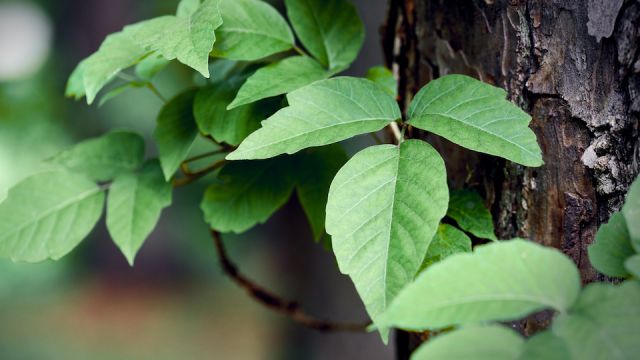Summer means many things, beautiful gardens, backyard fun, and long walks in nature. Unfortunately, nice weather also means a few not-so-attractive things like mosquitoes and the dreaded poison ivy. You may have heard the Ben Franklin saying, “ Leaves of three, let them be.” This is good advice to avoid this vining plant that can cause an irritating rash. To keep you and your family safe from this dangerous plant, there are a few other things that you need to know.
How does poison ivy grow?
Found throughout most of North American apart from the desert, Alaska, and Hawaii, poison ivy grows in open fields, wooded areas, along roadsides, urban areas and even backyards.
Poison ivy leaves grow in groups of three, with the middle leaf being a bit bigger than the two on either side. The veins in the leaf are opposite one another and grow upward in a V-shaped pattern. In the spring, the leaves have a red tint to them before becoming shiny green in the summer. By fall, the leaves turn various shades of orange, red, and yellow. As poison ivy vines age, the stems become woody and have unique “hairy” root growths. Vines are often found growing up trees, fences, or other plants.
Confusing poison ivy with other plants
Although poison ivy is pretty easy to identify, once you know what you are looking for, it is often confused with other, similar-looking plants. Both poison oak and poison sumac can be confused with poison ivy. Furthermore, young ivy likes to hide with other weeds and plants, making it hard to see.

You can get a rash without even touching poison ivy
Poison ivy contains an oil called urushiol what easily transfers from plants to people and objects, including tools, clothes, shoe bottoms, and even pets. This is how you can get a rash without even coming in direct contact with the plant. Urushiol is found in all parts of the poison ivy plant, not just the leaves. Sadly, it can even remain viable after the plant is dead. What this means is that you can still be impacted by the plant in the dead of winter when vines are leafless. You can even develop a rash by handling vines that have been killed by a weed killer.
Are some people more susceptible to poison ivy than others?
About 85% of the population develops a rash when they come in contact with urushiol from poison ivy. Some people, however, are more sensitive than others. Those in the age group of 5 to 20 are most sensitive, and sensitivity seems to lessen after people turn 30.
If you come in contact with urushiol and don’t develop a rash, this does not guarantee that you won’t get a rash the next time. Keep in mind that just because you’ve never gotten a rash, doesn’t mean that you can’t get one.
A common misconception is that you can build immunity to poison ivy by eating the leaves of the plant. This is a very dangerous myth because eating the leaves can cause a serious rash in your throat.
It is important to note that a poison ivy rash itself is not contagious. This means that you can’t get it by touching someone else’s rash or blisters. You can, however, contract the rash if someone has not washed the oil from their skin. This is how you can spread the rash around your own body – making it extra important to wash, wash, wash with soap, and water as soon as you know that you have been exposed.
Why you should never burn poison ivy or use a weedeater or mower to eliminate
You may have heard that a good way to get rid of poison ivy is to burn it. This actually creates issues of its own and should be avoided at all costs. When you burn poison ivy, it releases toxins into the air that can cause a rash within your lungs that can even be fatal.
Another eradication mistake is to use a string trimmer or mower on poison ivy. Doing so will result in oils being dispersed into the air. They can land on your clothes, skin, in your eyes, ears, and other parts of your body.
Best eradication techniques
At home, it is best to keep your yard as weed-free as possible. Identify areas where you have poison ivy and flag them immediately so that no one in your family comes in contact. Keep all pets from this area as well until you can do a proper eradication.
One of the best ways to eliminate poison ivy is to make a homemade potion.
- 1 cup of salt
- 1 Tbsp dish soap
- 1 Tbsp vinegar
- 1 gallon of water
What to do:
- Mix in a sprayer and spray poison ivy until it dies. This can take a little bit, so be patient.
- Another eradication option is to use boiling water to drown the roots. This can kill aggressive ivy but also takes several applications.
- You can also pull the plant out of the ground completely. This works well for small plants.
- Bag any plants in a heavy-duty garbage bag for disposal.
Note: After eradication, be sure to wash all clothes and the washer after using it. Scrub boots and shoes with soapy water.
Don’t let poison ivy ruin your summer fun!
-Susan Patterson




